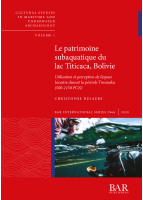Description
Ce livre propose de réexaminer l’étude de l’occupation du basin lacustre du lac Titicaca durant la période Tiwanaku (500-1150 PCN) en développant le concept de paysage culturel lacustre. Souvent considérées comme des ‘cultures de la terre’ (agriculture, pastoralisme, etc.), les sociétés préhispaniques du lac Titicaca ont, en réalité, développé, de nombreuses pratiques propres aux ‘cultures de la mer’ (navigation, offrandes, etc.). Que ce soit sur le plan politique, socioculturel ou rituel, le lac a eu une incidence sur l’évolution de ces populations et a favorisé l’émergence de pratiques indissociables à un espace lacustre. Les discussions proposent une nouvelle ‘vision’ de l’archéologie au lac Titicaca en intégrant le facteur lacustre dans l’interprétation des cultures Tiwanaku, et en conciliant nos connaissances actuelles des ‘archéologies’ du lac Titicaca, qu’elles soient ‘terrestres’ ou ‘subaquatiques’.
This book re-examines the occupation of the lake basin at Lake Titicaca during the Tiwanaku period (500-1150 AD) using the concept of ‘lacustrine cultural landscape’. Considered as ‘cultures of the land’ (agriculture, pastoralism, etc.), the pre-Hispanic societies of Lake Titicaca developed many practices specific to ‘cultures of the sea’ (navigation, offerings, etc.). Whether politically, socio-culturally or ritually, the lake has had an impact on the evolution of these populations and has encouraged the emergence of practices that are inseparable from a lake area. Delaere proposes a new ‘vision’ of archaeology at Lake Titicaca by integrating the lacustrine factor into the interpretation of Tiwanaku cultures, and by reconciling our present knowledge of both terrestrial and underwater ‘archaeologies’.
AUTHOR
Christophe Delaere est chercheur titulaire d'un doctorat en archéologie de l'Université libre de Bruxelles (Belgique). Depuis 2007, il mène des recherches dans les Andes (Bolivie, Pérou) et dirige un projet de fouilles archéologiques subaquatiques au lac Titicaca depuis 2012. Il s'est également spécialisé dans l'archéologie des eaux intérieures.
Christophe Delaere is a researcher with a PhD in Archaeology from the Université libre de Bruxelles (Belgium). Since 2007, Delaere has been conducting research in the Andes (Bolivia, Peru) and has been leading an underwater archaeological excavation project at Lake Titicaca since 2012. He specialises in inland waters archaeology.
REVIEW
‘Cette contribution est pionnière.’ Professor Thérèse Bouysse-Cassagne, Directrice de Recherche Emérite au CNRS (Centre de Recherche et de Documentation sur l’Amérique Latine)
‘[T]here has never been such a detailed and theoretically sophisticated account of underwater archaeology, nor a work that effectively integrates our present knowledge of both terrestrial and underwater “archaeologies”.’ Dr Juan Villanueva Criales, Museo Nacional de Etnografía y Folklore, Universidad Mayor de San Andrés
‘This book is a very important contribution to the knowledge of the cultural relations between the coastal communities and their lake environment during the Tiwanaku period (500-1150 AD).’ Dr Éric Rieth, Université Paris 1 Panthéon-Sorbonne











